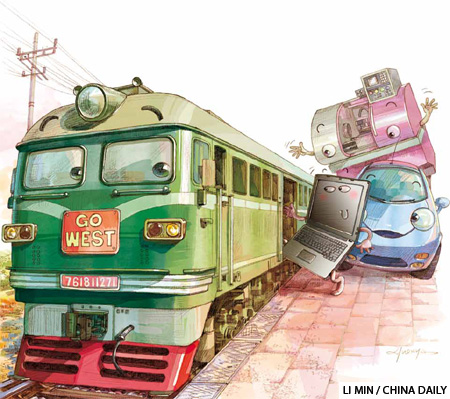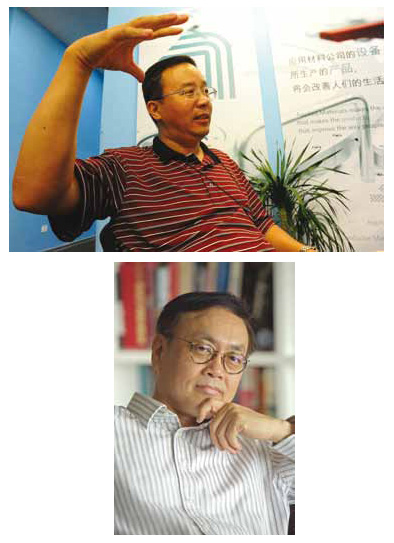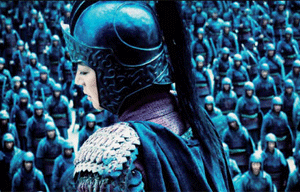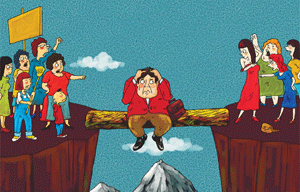Journey to the West
Updated: 2011-10-21 08:59
By Andrew Moody, Hu Haiyan and Ma Wei (China Daily)
|
|||||||||

Rising labor costs in the east, and incentives in the west, push and pull manufacturers
|
||||
Republican frontrunner Mitt Romney was among those accusing China of unfair competition earlier this month.
The reality, however, is of China's manufacturing competitiveness eroding rapidly.
Wage rates in China's key manufacturing heartland of Guangdong have increased by 158 percent over the past 10 years and by 11 percent in the year to 2010. Some other areas of the country have seen even bigger rises.
The question therefore arises of not how to stop the China export juggernaut but whether the country has a significant shelf life left as a major manufacturer.
A number of multinationals as well as companies from Hong Kong, Taiwan and the Chinese mainland are moving some of their production to nearby Southeast Asian countries, particularly Vietnam and Cambodia, where wage rates are often a fraction of those in China.
Only last week, German Chancellor Angela Merkel was on a two-day visit to Vietnam with German companies looking for cheaper manufacturing sourcing opportunities.
A central plank of Chinese government policy, particularly with its go-west (or western development) campaign, has been to provide financial incentives for companies to relocate in areas of the country where wages are lower.
Edward Tse, chairman, Greater China of Booz & Co, a leading global management consultancy, says many low-tech manufacturers have reached a critical stage.
"I know for a fact quite a number of companies, particularly those in areas like apparel and shoes, are now saying that China is too expensive and they want to go to other countries such as Vietnam, Bangladesh and Myanmar and so on. For the lower tech sectors, we are already seeing a degree of exodus," he says.
Tse says it is difficult to speculate whether China has a five, 10 or 20-year future as a major manufacturer.
"I don't have a precise answer but I think it is not just going to be a couple of years. I think I am a little bit more optimistic than perhaps some people who say that China is done now for that," he says.
The central problem though is escalating wage inflation, which might be good for creating a consumer society but in the short term is undermining industrial competitiveness.
"China is definitely experiencing high wage inflation, which was between 15 and 20 percent in 2010 and will probably be the same again this year and next year," says Michael McCool, vice-president of management consultants AT Kearney in Hong Kong and who leads the firm's supply chain services in Greater China.
Those behind the government's go-west strategy are not trying to lure China's plastic bucket and cheap toy manufacturers so they can benefit from cheap labor.
The $325 billion (236 billion euros) that has been pumped into 12 provinces, autonomous regions and municipalities in the west of China over the 10 years the program has been running is instead intended to take China up the manufacturing value chain.
New industrial centers like the Chongqing Liangjiang New Area, the economic zone launched last year and the Xi'an Hi-Tech Industries Development Zone (XHTZ), one of six zones the Chinese government wants to turn into world-class science parks, both of which cover vast areas of their respective cities, are designed to attract more high tech manufacturers.
Lei Yingjie, director of Xi'an Development and Reform Commission, who has responsibility for implementing the go-west campaign in the western city of Xi'an, says it is about looking forward.
"We don't want backward industries. We don't want cheap manufacturing companies coming to the west. We want high-valued-added manufacturing companies and knowledge-based industries," he says.
Zou Gang, general manager of US solar power company Applied Materials and China chief technology officer, based in Xi'an's XHTZ, says wage rates are not a major problem, the higher up the manufacturing scale you go.
"If you compare with the consumer industry, we are not volume at all. We sell systems by hundreds and thousands not by millions. Labor is less of a problem if you are doing high-tech manufacturing," he says.
Many companies of China's low-tech manufacturers are aware it would be something of a failing shortsighted strategy to move inland simply to save on labor rates.
They can clearly see the writing on the wall of labor rates rising steadily like a slow tsunami across the whole country.
As a result, if companies decide to move or build new manufacturing bases, they are increasingly likely to factor in future wage rises.
"What you are seeing when factories are being built afresh is that they are modeled with higher labor costs in mind so they are being designed with higher levels of automation than would have been the case 10 years ago," says McCool at AT Kearney.
"A toy manufacturer might therefore have moulding machines with more cavities so more toys can be made with one press."
One major manufacturer in China has already signaled its intention that it intends to significantly increase its level of automation.
The Taiwanese computer components giant Foxconn, which itself has gone west by setting up a major base in Chongqing, announced in July it was to deploy 1 million robots within three years to replace more expensive labor.
The company, which makes products for Apple and Hewlett-Packard and has been dogged by stories of worker suicides at its main base in Shenzhen, currently has just 10,000 robots.
This level of automation will provide in itself major opportunities for new Chinese manufacturing companies to make robots and mechanization equipment, where currently Swiss and Japanese companies often have an advantage.
McCool says China also has a rich pool of labor ideally suited to new more automated manufacturing processes.
"Where China has a very large advantage is in tertiary-educated staff. The programming of the control computers as well as the maintenance of the high-tech equipment can be done by Chinese professional and technical grades very much cheaper than their counterparts in the United States," he says.
Eric Thun, lecturer in Chinese business studies at the Said Business School at Oxford University, who is currently on a visit to the west of China, says it is far too early to write China off as a major manufacturing center.
"What drives a country's ability to be a manufacturing powerhouse is not low cost labor. The United States itself is an example of that. It lost its competitiveness on the basis of labor costs long ago but continues to be a very significant manufacturing force as does Germany with even higher labor costs," he says.
"They have maintained that position by moving into areas that are both capital and technology intensive and that is exactly the challenge that China faces today."
Many believe the scope for moving vast tracts of China's manufacturing base to cheaper labor countries like Vietnam is often significantly exaggerated.
McCool believes there might be opportunities in the near term but eventually it will not be possible at all.
"You basically have to get to Vietnam before it becomes full. When you look at it on a macro scale only 10 percent of China's production could go to Vietnam because it just doesn't have the capacity or the systems to support it," he says.
Zou Gang at Applied Materials in Xi'an is one who believes China will find a solution to any current waning of its manufacturing competitiveness.
"There are so many predictions about the China economy, that it is going to collapse or explode. I think whether China continues to succeed as a manufacturing nation will depend on the manufacturers themselves and if they and the Chinese government do the right things it can remain dominant for 20, 30, even 50 years," he says.
|
Top: Zou Gang, general manager of Applied Materials in Xi'an. Above: Edward Tse, chairman, Greater China of Booz & Co. Photos Provided to China Daily |













